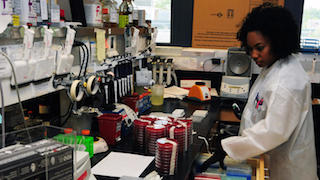mcr-1 gene
See the following -
A 'Slow Catastrophe' Unfolds as the Golden Age of Antibiotics Comes to an End
 In early April, experts at a military lab outside Washington intensified their search for evidence that a dangerous new biological threat had penetrated the nation’s borders. They didn’t have to hunt long before they found it. On May 18, a team working at the Walter Reed Army Institute of Research here had its first look at a sample of the bacterium Escherichia coli, taken from a 49-year-old woman in Pennsylvania. She had a urinary tract infection with a disconcerting knack for surviving the assaults of antibiotic medications. Her sample was one of six from across the country delivered to the lab of microbiologist Patrick McGann...
In early April, experts at a military lab outside Washington intensified their search for evidence that a dangerous new biological threat had penetrated the nation’s borders. They didn’t have to hunt long before they found it. On May 18, a team working at the Walter Reed Army Institute of Research here had its first look at a sample of the bacterium Escherichia coli, taken from a 49-year-old woman in Pennsylvania. She had a urinary tract infection with a disconcerting knack for surviving the assaults of antibiotic medications. Her sample was one of six from across the country delivered to the lab of microbiologist Patrick McGann...
- Login to post comments
Bacteria That Resist 'Last Antibiotic' Found in UK
Bacteria that resist the most common antibiotic of last resort - colistin - have been discovered in the UK. Officials say the threat to human health is low, but is under ongoing review. Scientists warned the world was on the cusp of a post-antibiotic era when such resistance was discovered in China last month. Now checks have discovered the same resistance on three farms and in samples of human infections...
- Login to post comments
L.A. County Patient Was Infected with Drug-Resistant E. coli
Scientists were alarmed last year when they found that a woman in Pennsylvania had been infected with bacteria that was resistant to colistin, an antibiotic that is considered the last line of defense against particularly nasty illnesses. It was a scary reminder that bacteria are increasingly able to survive antibiotics, making some infections extremely difficult or even impossible to treat. Now California is on a list of six states where patients have been infected with bacteria that contains a gene known as mcr-1, which makes it resistant to colistin...
- Login to post comments
Peer into the Post-Apocalyptic Future of Antimicrobial Resistance
Aout 4 million years ago, a cave was forming in the Delaware Basin of what is now Carlsbad Caverns National Park in New Mexico. From that time on, Lechuguilla Cave remained untouched by humans or animals until its discovery in 1986—an isolated, pristine primeval ecosystem. When the bacteria found on the walls of Lechuguilla were analyzed, many of the microbes were determined not only to have resistance to natural antibiotics like penicillin, but also to synthetic antibiotics that did not exist on earth until the second half of the twentieth century...
- Login to post comments
Peer into the Post-Apocalyptic Future of Antimicrobial Resistance
Aout 4 million years ago, a cave was forming in the Delaware Basin of what is now Carlsbad Caverns National Park in New Mexico. From that time on, Lechuguilla Cave remained untouched by humans or animals until its discovery in 1986—an isolated, pristine primeval ecosystem. When the bacteria found on the walls of Lechuguilla were analyzed, many of the microbes were determined not only to have resistance to natural antibiotics like penicillin, but also to synthetic antibiotics that did not exist on earth until the second half of the twentieth century...
- Login to post comments